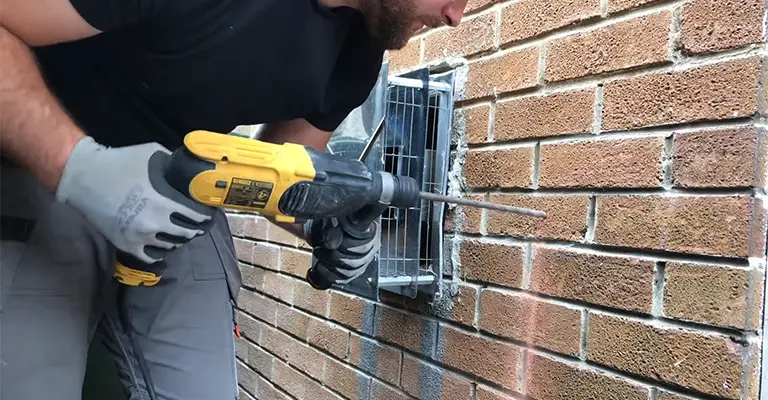Many people have a fear of drilling straight into a wall. What if they go too far and hit the other side? Or what if they break through the other side of the wall and ruin the drywall on the other side?
The most important thing to consider when drilling into a wall is to know the distance between the wall and where you want to drill. For example, if you are drilling into a stud, there should be at least 3/4″ of space between the wall and the stud.
This is because drilling into a stud can cause damage, such as cracking or breaking the drywall or damaging electrical wires. Now, when drilling a straight hole, things get a bit complicated.
Simple Ways to Drill a Hole in the Wall With A Handheld Drill
It is essential to make a few preparations before using a handheld drill. Your wood block is an excellent guide to use before drilling into any surface. You can easily make a perpendicular hole if you hold a square on your workpiece.
However, if you want to drill on the square, you should position the top and/or the side of the drill up against it. To ensure a square stand straight, use a speed square or try a square, which has flat sides.
You can substitute a square-cut block of wood for a square if you don’t have one. The hole you drill in the wood should be the same size as the one you drill in the surface.
The next step is to mark the wall’s position. Then, make sure the hole in the wood matches the mark. From your drill bits, you need to choose the right size drill bit for the hole you want to make.
Then, drill slowly into the wall after passing the drill through the hole in the wood block. The drawbacks of this method include the fact that not every drill bit is straight across the top or along the side of the body.
In addition, the drill bit may be at an angle if its body is not completely aligned with the square. The drill bodies on most drills are pretty flat and are fairly easy to adjust.
Tips For Drilling Super-Straight Holes
A DIYer of any skill level may struggle to drill a perfectly horizontal hole in a wall, but beginners are even more likely to struggle. The following tip will make it easier for you to drill straight holes.
A quick hack can help you drill perfectly perpendicular holes through wood if you’re constantly frustrated.
1. Drilling The Straightest
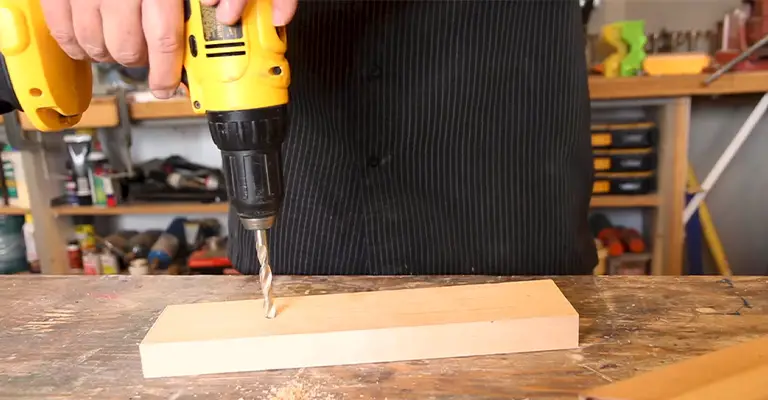
Hand drills can be turned into portable drill presses with guide attachments.
As with a drill press, the depth of the hole can be set, and the angle of attack can also be adjusted. However, with this attachment, you don’t have to worry about packing up your drill press.
2. Drilling Straighter
Build a right angle by nailing together some scrap pieces of 1 x 2. You will waste your time if you don’t make everything true and square. Next, make sure your drill bit is positioned tightly into the jig’s corner and bore your hole.
3. Drilling Straight
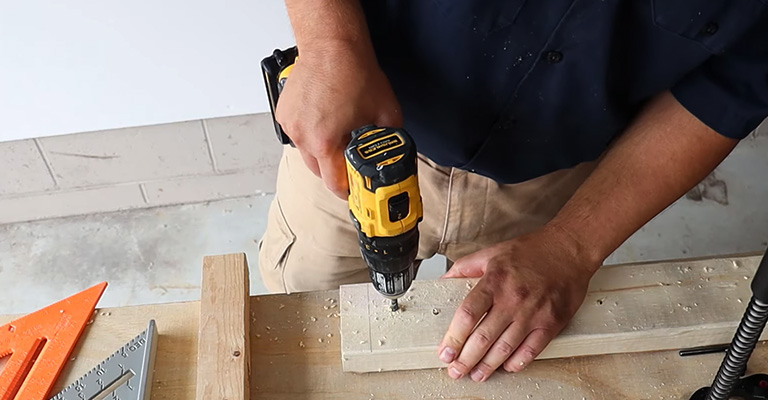
Are you lying around with an old CD? It’s obvious that you do. On the workpiece, place the label side down and center it over the hole you want to make. As you drill, position the bit in line with its reflection so that it is straight with the hole in the disc.
How To Drill Straight 90° Holes Without a Drill Press?
Drill holes should always be perpendicular to the surface, except when you deliberately choose a particular angle or bias. With a drill press, you can easily accomplish this.
Drilling into a wall or cabinet door requires using a hand drill/driver, but there are plenty of occasions when the tool is needed.
It is common to find drills with bubble levels, but they can only help in certain situations since most walls aren’t exactly flat and straight.
You can purchase a portable drill guide if you buy a specific type of jig. Big Gator Tools makes a good one. The good news is that you can easily make one with just wood scraps at home at no cost.
To begin, glue some scrap hardwood into a basic L-shape. Then, a 90° angle can be achieved by gluing and clamping the blocks against a square.
Add some string or wire to one side after the glue dries so it can be easily stored. In addition to my drill, some bits, drywall anchors, and a small level, I keep mine on a clip in my tool bag.
Using this square won’t damage your drill bits or cause metal shavings to fly everywhere if you use it while the spinning bit is cutting.
You can use your drill level to help you find the bubble on the bit by butting both sides against it. If you want to check all sides, you can flip it over.
Whenever it wears out from spinning bits, just glue another one up! With a quick reference like this, you’ll be surprised how much difference it makes.
Drilling Straight Holes With A Drill Press
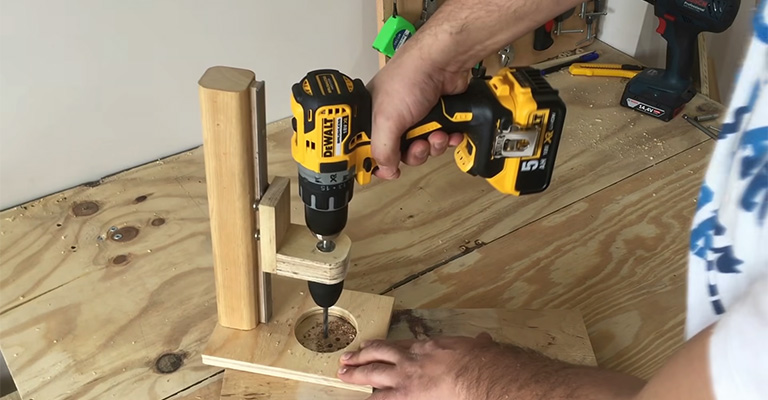
To make dead straight holes, you can also use another tool. Preparing your surface in advance is important when using a portable drill.
Step One
Putting a flat piece of wood or plastic on the drilling surface is the first step. To drill through your desired surface, you will need to refer to this reference.
To attach the wood or plastic to the drill, use some hot glue if you are having trouble keeping it in place.
Step Two
Once the reference point has been drawn, you will need to draw a parallel line from the drill bit to remove the block. Then, cut the block along the drawn line.
Another option is a plywood stand in the shape of an ‘L’. As a result, your surface will be perfectly accurate since you will have a reference point of 90 degrees.
Step Three
A perfectly straight hole can be made once your reference blocks are in place.
The reference blocks will act as support instead of relying on your eyes alone to stop your drill press from moving.
Mistakes To Avoid
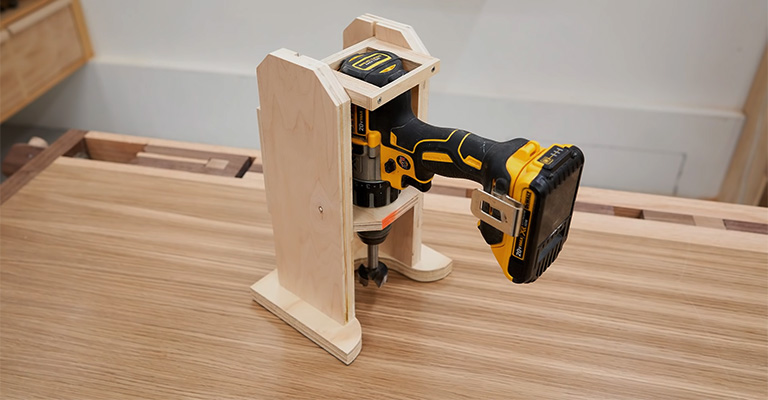
Getting a perfectly straight hole means avoiding some common mistakes. To achieve a straight hole, follow these tips.
Ensure that the drilling spot is marked with a pencil or pen before starting. It will be easier for you to drill and place your guide if you know exactly where you need to drill.
Before you begin drilling, clamp your wood, plastic, or metal. A tight clamp will prevent your material from moving around, and your straight line will remain intact.
Slowly begin. If you drill at full speed straight away, you can split your reference and be at risk of injury. Instead, keep your drilling line straight by increasing your speed slowly.
Using lubricant on your drill bits will help them perform better. In addition, you will be able to drill through the harder surface much more easily if you do this.
Ensure that your hole is smooth when it is drilled. Run your drill on the outside of the edge of the hole in low power mode to remove any sharp pieces.
Pro Tips:
Drill bits with good quality! The best way to improve your results is with SHARP bits with pilot points. It’s nothing crazy expensive, but a good set of these makes a huge difference.
My favorite 1/4″ hex shank “quick change” bits are for general use just because they are convenient. It might not be acceptable to purists, machinists, or those who require crazy strength or accuracy.
But, in your junk drawer, there are old loose bits of black oxide. Although this isn’t the best solution for this application (drilling screw holes in walls), I am putting it on your radar for the future.
The term “drill jig” can be found on Amazon or elsewhere, and there are devices that can make hand drilling easier. Furthermore, a heavy drill might make it more difficult if you are a large or strong individual.
Finally, using a cordless device will allow you to use a smaller battery, and lithium batteries are much lighter than NiCads. You’ll unlikely need a heavy-duty, all-metal monster, much less a hammer drill, for your needs.
Note From The Author:
There are several methods for drilling a straight hole. The best option is probably to use a drill press, but it isn’t always the easiest. Even homemade references can be very helpful, as we discussed earlier.
To get the result you want, you don’t need store-bought items. If you don’t have the time to purchase some of the tools we listed, household items like CDs are great alternatives. If you hold them carefully, they will hold your drill in place.
The perfect hole should be drilled today if you follow all the necessary precautions, follow strict guidelines, and maintain your tool properly.
Final Words
The ass end of the drill should be considered when drilling straight holes. Once the bit is in the right place, just pay attention to the back of the drill once you’ve set it in place.
To keep it lined up, you can even use your other hand. Using a nail set can also help if your bit is slipping initially, so you can start slowly until the bit bites into the material.
In addition, you should pay attention to your body position when drilling. If your body is not properly behind the drill, you will have a much harder time drilling straight.

